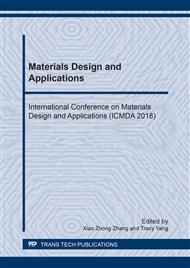p.3
p.9
p.17
p.25
p.33
p.43
p.51
p.61
Preparation of TiO2-Reduced Graphene Oxide Nanocomposites for Sunlight Degradation of Methylene Blue
Abstract:
Photogenerated electron/hole recombination greatly limits the catalytic efficiency of TiO2, and recently modification with graphene substance has been regarded as an effective way to enhance the photocatalytic performance of TiO2. When referring to the fabrication of graphene based materials, the reduction process of graphene oxide has been demonstrated to be a key step. Therefore, it is highly required to develop an efficient and simple route for the GO reduction and the formation of TiO2-reduced graphene oxide (RGO) nanocomposites. In this study, TiO2-RGO nanocomposites were prepared by a facile and efficient one-step hydrothermal method using titanium (IV) butoxide (TBT) and graphene oxide (GO) without reducing agents. This method shows several unique features, including no requirement of harsh chemicals and high temperature involved, one-step hydrothermal reaction for mild reduction of GO and crystallization of TiO2 running in parallel, and the production of TiO2-RGO nanocomposites in a green and efficient synthetic route. In addition, the photocatalytic activities of the synthesized composites were systematically evaluated by degrading methylene blue (MB) under sun light irradiation. The TiO2-RGO nanocomposites show a superior photocatalytic activity to the synthesized pure TiO2. It is also found that the concentration of RGO in the nanocomposites plays a key role in the photocatalytic activity. Specifically, the composite with 1 wt % RGO shows the best photocatalytic activity, probably due to the reduction of the electron-hole recombination rate.
Info:
Periodical:
Pages:
17-23
Citation:
Online since:
October 2018
Authors:
Keywords:
Price:
Сopyright:
© 2018 Trans Tech Publications Ltd. All Rights Reserved
Share:
Citation:


